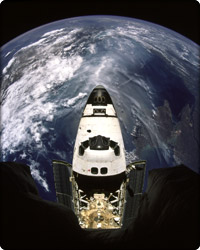Forecast worsens slightly for space shuttle launch but weather is still favorable
The launch still was scheduled for Thursday night.

The first problem Tuesday dealt with a power surge which shot through one of the space shuttle's power systems during preparations overnight, although key elements such as the external tank, the solid rocket boosters and the main engines probably were not affected, said LeRoy Cain, launch integration manager.
The second concern was with an adhesive that helps seal some of the joints on the reusable solid rocket motor which may have failed a routine test of its bonding strength. Engineers, though, were not worried about hot gases escaping from sealed joints since there were back-up systems to keep them in check.
"We're probably not going to have any issues, but we want the teams to go off and assess that everything is OK," Cain said. "If there is anything we need to retest or check out more so than what we otherwise would do ... we want to talk about that."
The weather forecast for the planned liftoff of Discovery was downgraded slightly Tuesday but still remained favorable for the first night space shuttle launch in more than four years.
Concerns about clouds over the Kennedy Space Center at the launch time of 9:35 p.m. EST Thursday caused forecasters to reduce the chances of favorable weather to 60 percent from 80 percent. Strong wind was expected on Friday and Saturday, diminishing the chances of good launch weather for those days to 40 percent.
"The first day is the best day weatherwise," said Kathy Winters, shuttle weather officer.
Weather will improve early next week. NASA has four launch opportunities over five days, if needed, to start the 12-day mission.
The space agency likely will not attempt to launch past Dec. 17 since flight controllers want Discovery on the ground before the new year. Shuttle computers are not designed to make the change from the 365th day of the old year to the first day of the new year while in flight. A potential solution to the problem has not been thoroughly tested.
In Houston, NASA worked on a software problem that had caused a breaker to open on a circuit to the motor that rotates the space station's giant solar arrays in the direction of the sun. The solar arrays will generate power for the space station after Discovery's mission.
NASA successfully tested the software fix on Tuesday, reports AP.
During their 12-day mission, Discovery's seven astronauts planned to rewire the space station, deliver a 2-ton (1.8-metric ton) addition and replace one of the space station's three crew members.
This is the first planned night launch in four years. NASA required daylight liftoffs for the three flights after the 2003 Columbia accident to make sure the agency could get good photos of the external fuel tank. Foam breaking off the tank at liftoff caused the damage that killed Columbia's seven astronauts.
Subscribe to Pravda.Ru Telegram channel, Facebook, RSS!





